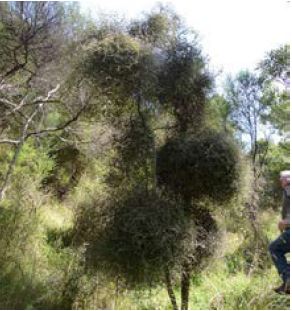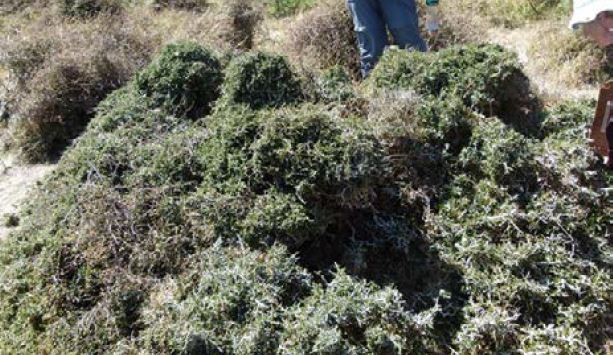Trip Report – 5 March 2016 : Tupoki Takarangi Trust, Wainuiomata Coast Rd
NZTopo50-BQ32 Lower Hutt
Following a visit to the Trust’s land on 1 August 2015, BotSoccers, plus some welcome guests, botanised some of the Trust’s land not traversed during the previous visit. This long but narrow strip of land (c. 177 ha), covers a wide range of ecosystems north of the Baring Head section of East Harbour Regional Park. The block is not open to the public without the Trust’s permission. It runs east from Fitzroy Bay across a coastal platform uplifted by earthquakes, up a very steep coastal escarpment, across the marine terrace, down the inland escarpment and across the Wainuiomata River flats, (including the river and an oxbow), to Coast Road. The property continues on up and over a large hill on the other side of Coast Road. We hope to be able to botanise this part in future. Marama Butler-Monu, a trustee, told me her grandparents lived onsite and crossed the river by a swing bridge. Marama and her siblings have wonderful memories of school holidays spent on the land. They are concerned about the quality of the water in the river and lack of native fish habitat.
We walked up a spur south of the gully that we botanised last year. On the marine terrace Pat Enright showed us Juncus distegis, a rush new to most of us, although according to NZPCN’s web site, it is widespread but local in its occurrence.
 |
Streblus heterophyllus. |
Amongst many other rush species it may be easily overlooked. Several species of rushes and sedges gave us the opportunity to learn a few more. There was much discussion about a bunch of Carex which were identified as Carex testacea, C. raoulii and / or C. “raotest”. Pat has now confirmed them as all C. “raotest” which differs from C. raoulii by all its terminal spikelets being male. The bush in this block is relatively diverse, considering its grazing history. Of note was a wonderfully shaped Streblus heterophyllus near the head of the gully, numerous Pseudopanax crassifolius, and Clematis forsteri in seed. The two C. vitalba / old man’s beard plants found were pulled out by Gavin, Sunita and Eleanor.
We lunched on the marine terrace, taking in magnificent views to the west and south. After lunch the Wairarapians left to return via the inland gully as they had not attended the previous trip, so were keen to see the wetland on their way home. The main group scrambled along and down the steep coastal escarpment on the lookout for species which have been found on adjacent Baring Head’s southern and inland scarps. Although we did not find matagouri, Brachyglottis greyii or Clematis afoliata, they may be present as we did not cover the entire escarpment. Unpalatable species were abundant such as Olearia solandri, Coprosma propinqua var. propinqua, and numerous Melicytus crassifolius. We saw a tangled mass of Rubus schmidelioides and R. squarrosus near the bottom of the escarpment. Beyond it we found remnants of a stone wall which had previously protected gardens, and an area rooted by pigs. The rooted area was an old fire site, with small chunks of charcoal, and was near a grove of old karaka. Near the karaka was a thicket of Spanish heath / Erica lusitanica, which although abundant along Coast Road, were the only plants we saw on the land. A huge Melicytus crassifolius, although severely grazed by sheep, is still dense enough to provide habitat for native lizards.
 |
Melicytus crassifolius. |
We walked along the farm track heading south into the Baring Head section of East Harbour Regional Park. We noted sprayed gorse on the coastal platform, and numerous pest-animal traps, while looking for botanical treasures, then climbed the hill, and descended to the car-park.
Although we saw few cattle, they are damaging the wetlands, and tracking through the bush, opening up light-wells for invasive pest plants. Horses may also be grazed occasionally, as we saw manure on the costal edge.
The land would benefit immensely from allowing the block to be grazed only by sheep, as they would not enter wetland, unlike cattle, and they are not usually keen to enter thick bush. The high value areas could be fenced off from stock, or the number of sheep reduced, to allow regeneration of the bush areas. Because this land is part of the Greater Wellington Regional Council’s Baring Head Key Native Ecosystem, I recommend the river margins be fenced off from stock, the old man’s beard site resurveyed for any new plants next spring, and the Spanish heath controlled as soon as possible.
Participants : Bev Abbott, Naomi Baggs, Eleanor Burton, Gavin Dench, Michele Dickson, Geoff Doring, Pat Enright, Bryan Halliday, Chris Hopkins, John Hornblow, Chris Horne, Pat McLean, Mick Parsons, Sunita Singh, Robyn Smith (leader / scribe), Debra Wootton.

 Site Index
Site Index







 Site Index
Site Index





